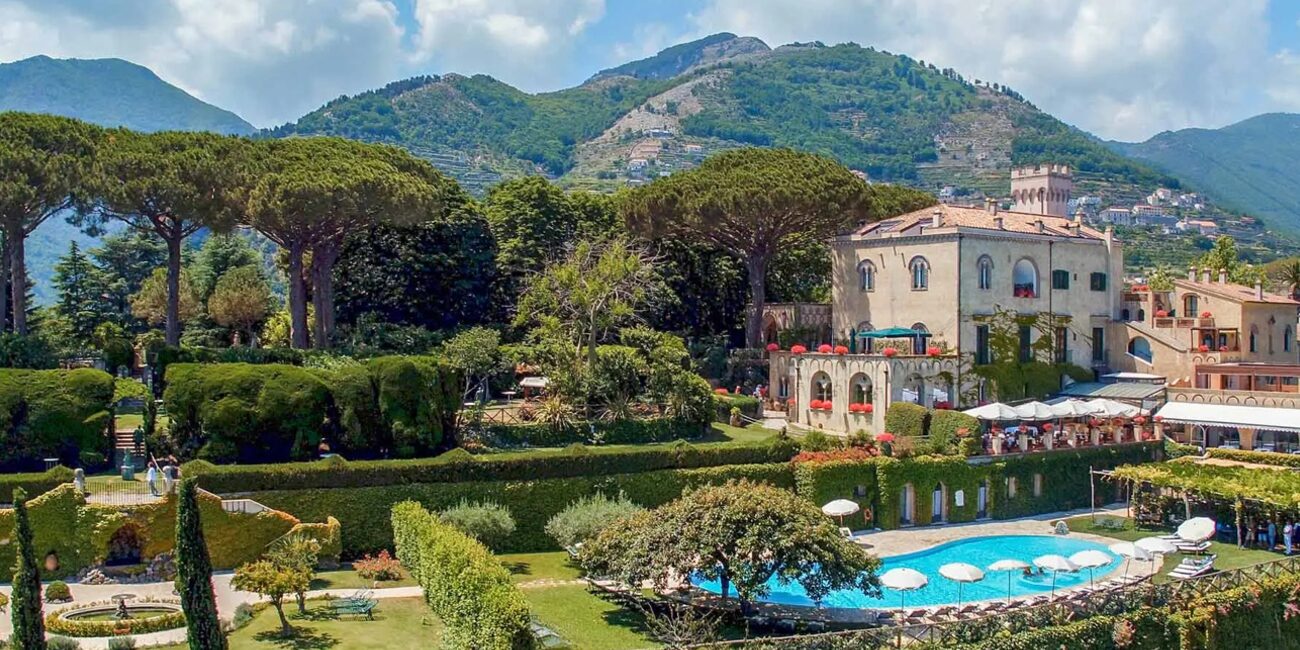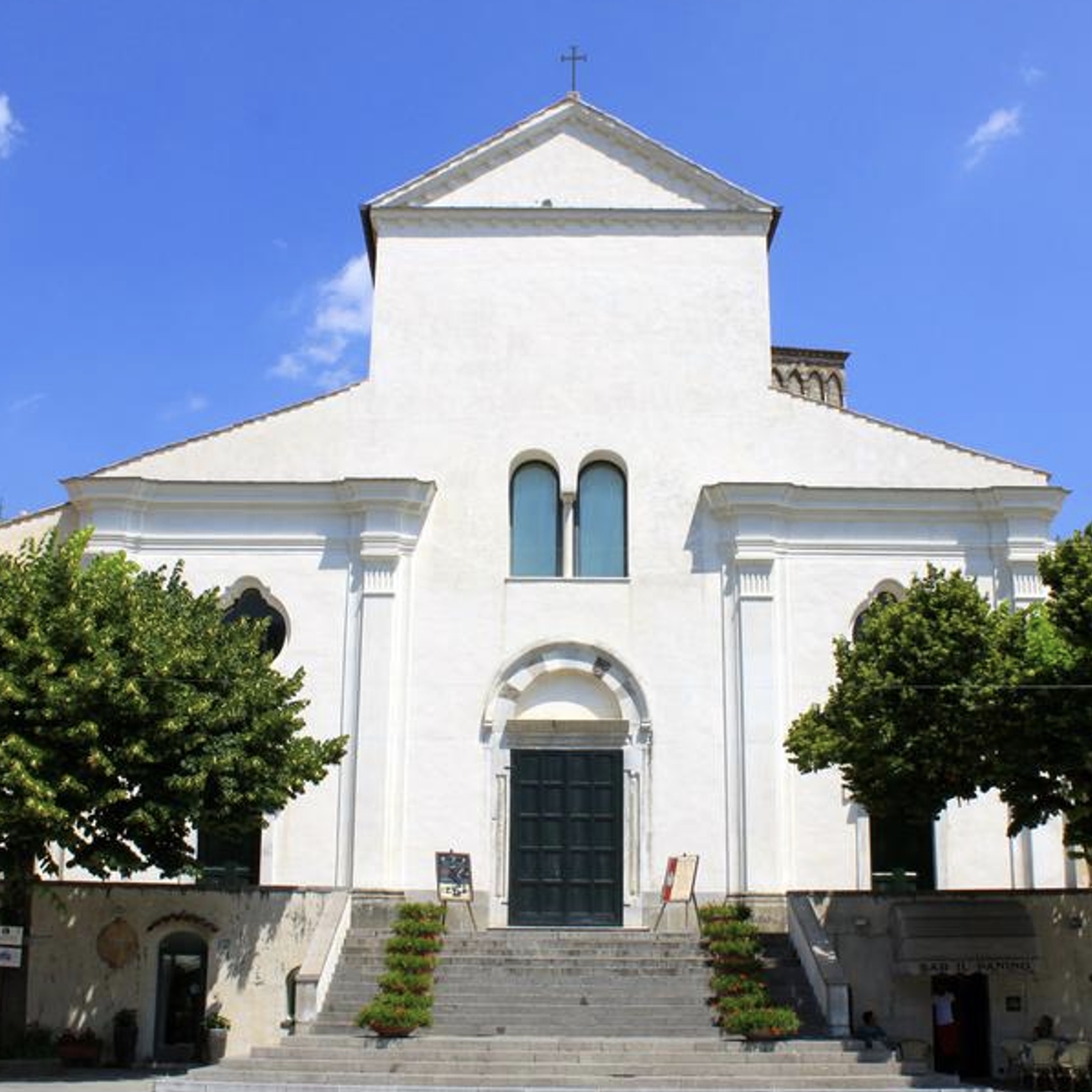Ravello
Having sprung up probably in the 6th century, it was populated, round about the year one thousand, by a group of nobles from the Maritime Republic of Amalfi who had rebelled against the authority of the Doge. The rebels made a good choice when choosing the site in which to built their refuge: Ravello rises in an easily defendable position.
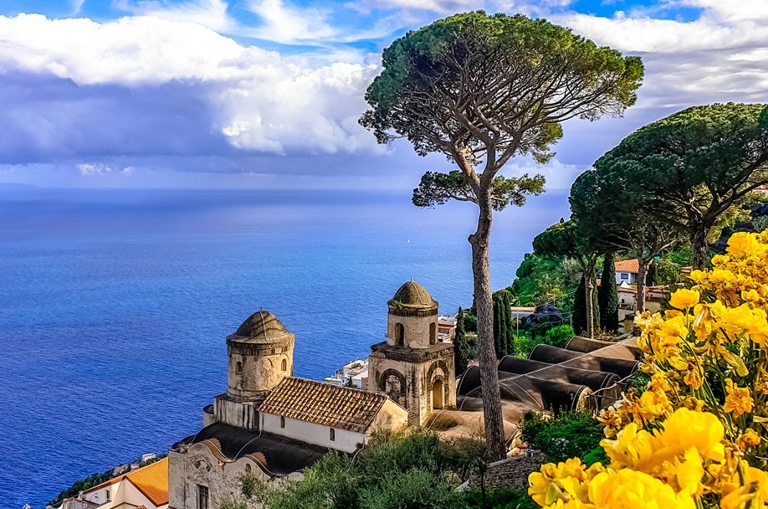
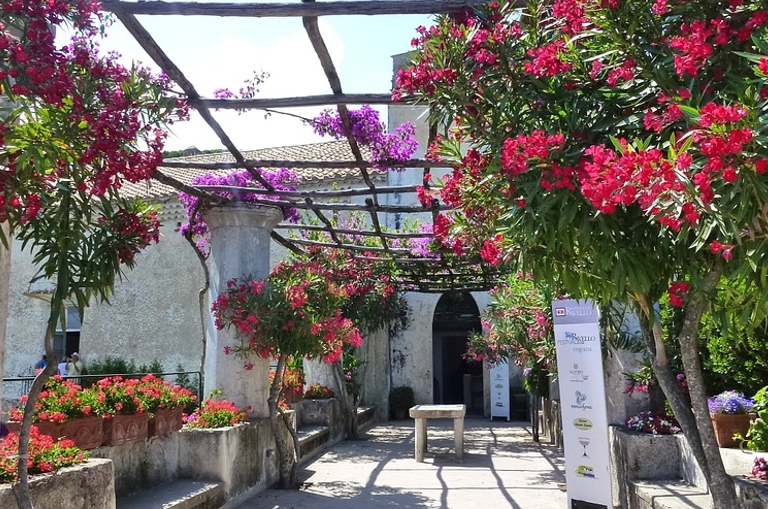
The city quickly prospered, thanks in particular to the flourishing wool-spinning mill, known in olden times as the “Celendra”, that on the 23rd of April 1292 was conceded to Bishop Giovanni Allegri by King Charles Il of Anjou, to provident agriculture and to the intense trade exchange carried out on the Mediterranean sea routes, especially with the Arabs and Byzantines.
In 1137 Bernardo da Chiaravalle described the city as “…ancient, well fortified and impregnable, as well as being opulent it is so beautiful that it can easily be numbered among the first and most noble cities …”.
History
The history of Ravello was strictly connected with the glorious and tormented history of the Maritime Republic of Amalfi, whose lot she followed. Its economic and political decline began in the Norman period and became dramatic in the course of the seventeenth century: having lost its prosperous economy, Ravello had only… all the rest: an incomparable position from the naturalistic point of view and architectural and artistic marvels built during the centuries of splendour.
The churches in Ravello are filled with references to the story of Jonah and the Whale; the Ambo in the Duomo, for example, is decorated with two mosaics portraying Jonah being first swallowed by the whale and then being spat out.
Another popular legend holds that when the devil wanted to tempt Christ with the wonders of the world, he took him to Ravello.
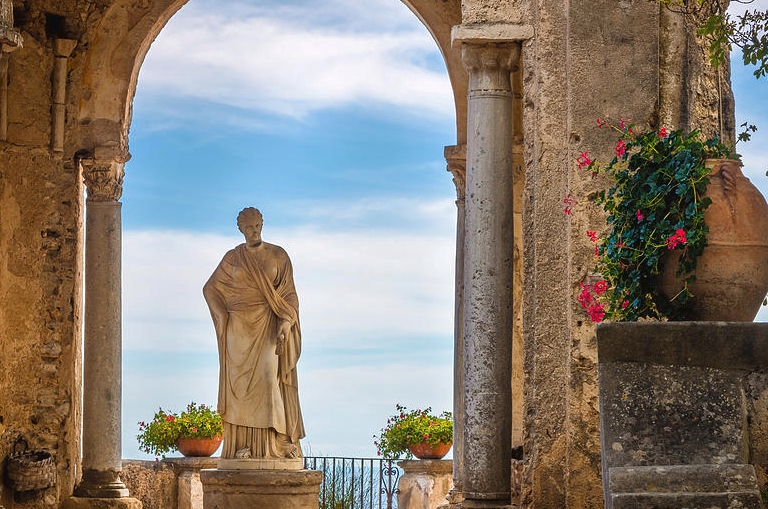
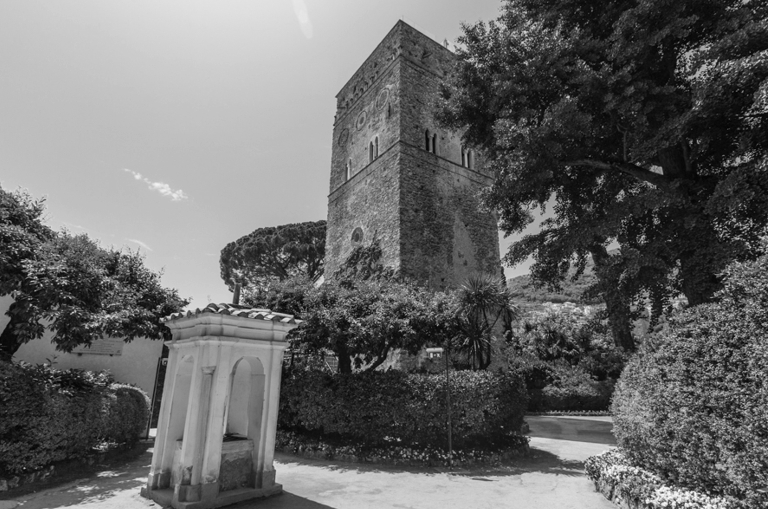
Things to see and do in Ravello
Overlooking the Amalfi Coast, Ravello is the city of music, a medieval village full of winding cobblestone streets, lush gardens, and breathtaking views of the Mediterranean. Ravello is the ideal location for those wishing to relax in the form of delicious seafood meals and luxurious lodgings with restorative sea views.
Villa Rufolo
The garden of Villa Rufolo, known as the “Garden of the Soul”, occupies two levels and is reached by following a tree-lined avenue with a distinctly Victorian air. The ancient walls, almost hidden by cypresses and lime trees, leads to the Moorish cloister. You have time to savour the noble lines of the monument’s architecture before descending a few steps to the first level of the garden.
The redolent atmosphere infuses you with the spirit of the Romantic garden, with echoes of Boccaccio’s stirring poetry. The history of the garden can be divided up into three distinct phases:
The original phase, dating back to the 13th century, when the Villa was built.
The medieval phase, of which only a few traces remain, recalling the garden Boccaccio described on the first day of the Decamerone, when it may have extended all the way to the Mormorata, where the Rufolo family owned other land.
The Romantic phase, with Francis Nevile Reid as its genius loci, a Scottish philanthropist and expert on botany and ancient art, recognised in his appointment as Honorary Superintendent by the Prefect of Naples.
Reid’s tenure marked the renaissance of the gardens in Villa Rufolo and also the beginning of the Villa’s renown. It was in May 1880 that Wagner visited Ravello and “discovered” the enchanted garden of Klingsor as he had imagined it for his opera Parsifal. In his mind’s eye Wagner saw the imposing medieval tower collapse into the void and turn into a magical garden, with the tropical plants taking on the likeness of beguiling maidens, until the garden itself is transformed into a desert as Parsifal kills the wizard Klingsor.
Drawn by the mild climate and the beauty of the surroundings, Nevile Reid chose Villa Rufolo as his summer residence and began to stock the garden with various species of exotic plants.
In the course of time, and in particular in the twentieth century, the gardens have undergone a number of demolitions: during the war they were commandeered by the British forces; in 1951 they suffered from a particularly violent storm; and in 1955 the construction of the provincial road did away with the upper part of the garden.
Villa Cimbrone Gardens
The Villa’s gardens are breathtakingly beautiful and contain a wealth “of the most beautiful imaginable flowers”. They were largely redesigned at the start of the 20th century, with the valuable input of the English gardener Vita Sackville-West. They are considered among the most important examples of the English landscape and botany culture in the South of Europe.
As a result of the strong influence of classical literature and the reinterpretation of the Roman villa, numerous impressive decorative elements from all over the world were placed in the gardens, such as fountains, nymphaea, statues, small temples and pavilions. Some of them often hosted gatherings of the prestigious Bloomsbury Group, which chose Villa Cimbrone as a meeting place and source of inspiration.
The long central path, which in May 1880 provided the backdrop to the famous horse ride by Cosima and Richard Wagner, ends with the “Infinity Terrace”, where the gaze of onlookers is lost in what Gore Vidal called “the most beautiful view in the world” and where Gregorovius said that one feels “the desire to fly”.
Surely worth to see is the Infinity Terrace, the spectacle which this splendid, incomparable natural balcony, adorned with eighteenth century marble busts opens before the incredulous eyes of visitors truly comprehends something infinite but, any adjective to try and somehow describe this miracle of nature is ineffective.
Casting your eyes down as far as the mountains of Cilento and the tip of Licosa, over this sparkling sea, over the varied and multi-coloured Coast of Amalfi with its lemon groves, the little houses clinging to the hills, dazed by the scent of fruit and furze, the passing of time does not matter to us, bewitched by such beauty, such Divine generosity.
Auditorium Ravello
The history of the Auditorium in Ravello begins at the beginning of July 2000. During a conference organized by S3.Studium in Ravello, emerged inadequate infrastructure of Ravello and the need for an auditorium finally adapted to the needs of the country music and congress hall. The journalist Roberto d’Avila proposed as a designer Oscar Niemeyer, linked by esteem and friendship with Domenico De Masi. Encouraged by the then Mayor of Ravello Secondo Amalfitano, the same d’Avila, returned to Brazil, on July 7 became the spokesman of Domenico De Masi at Niemeyer and asked him to name the design of the auditorium.
The Architect gladly accepted the request and, for seventy days worked intensively on the project, as he himself said in interviews to the press and the Brazilian television. The September 23 2000, in his studio at n.3940 of Av. Atlantica in Rio de Janeiro, Niemeyer has delivered to Domenico De Masi, the “concept” consisting of a plastic and in some photos of the auditorium, accompanied by a design and dedication.
Ravello Music Festival
In July and August, the Ravello Festival – established in 1953 – turns much of the town centre into a stage. Events range from orchestral concerts and chamber music to ballet performances, film screenings and exhibitions. The festival’s most celebrated (and impressive) venue is the overhanging terrace in the Villa Rufolo gardens.
Visit the official webiste
Amalfi Coast Private Experience by Boat
Near place for departure: Amalfi
Duration: 8 or 4 hours
From: 700 €
A boat trip is the perfect way to discover the beauty of the Amalfi Coast in one day, leaving.
From Positano we will sail through Praiano, Marina di Praia, the famous Fiordo di Furore patrimony of the UNESCO and the beautiful Emerald Grotto.
The cruise follows to Amalfi the glorious Sea republic.
Departure from Positano along the way to Amalfi we will admire the unique scenery of our Amalfi Coast.
Then from our boat we will see: Praiano with the Gavitella beach, the “Grotta Dell ‘Africana” and Marina di Praia, a small fishermen village. It is possible also visit the Emerald Grotto (extra €5 pp cash to be paid directly there), this visit is optional, you can decide with the skipper if you want to visit it or not.
After this the excursion will restart passing through Conca dei Marini, the natural Arch, Amalfi, Atrani with the waterfalls of Marmorata. If you wish you can stop in Amalfi for have some free time to see the center of the town and enjoy a nice walk on the main street visiting the S. Andrea’s Cathedral.
The skipper can also book a table for you in a seaside restaurant along the Coast. You can stop for a swim in the limpid waters of the coast for a refreshing and relaxing bath. We will then return to Positano.
On board you can enjoy a wide selection of drinks available for you.
Ravello Wine Tour
Ravello, one of the most beguiling towns on Italy’s Amalfi Coast, is home to some lovely white wines and light reds made in the Costa d´Amalfi DOC appellation. But for serious wine lovers and especially for those who like intense red wines, you need to go a little further afield, deeper into Campania. You will visit two contrasting high-end properties, enjoy a tasting menu lunch at one of the estate’s refined restaurant and visit the small medieval hamlet of Taurasi. Learn all about Campania’s native grape varietals like the white Falanghina (actually a varietal that the Ancient Greeks imported) and the red Aglianico, making superb wines that have been called “Barolos of the south”. And take in some sightseeing, stopping in medieval Taurasi. We have prepared this one-day wine touring itinerary from Ravello for those looking for a luxurious excursion to the best wine estates in the region.
Book Now on: https://www.cellartours.com/italy/wine-tours/ravello
Leave a Reply
Do you have some comments or questions for us? We’d love to hear from you! Don’t be shy! Feel free to drop us a message!





